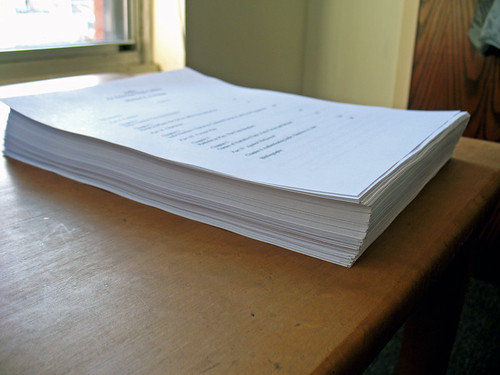
My year has been defined more than anything by being a parent of a very young child, a baby boy born in late November 2009. I saw many of my favorite movies of 2009 on video in early 2010 (A Serious Man and Inglourious Basterds were among them but The Hurt Locker was a disappointment, and none of what I have seen of the '09 vintage impresses me more than Up), and very few of what I expect to be my favorite movies of 2010. I also played a lot of video games, but few of the year's releases. This is in such contrast to earlier times in my life, when I had no television or gaming console, and would see several films a week, and not infrequently more than one a day in the theater. Over the years I have become just as interested in television as an object of study as cinema, and have been spending more home time with TV than movies for several years. With two kids and busy semester business for much of the year, in addition to a number of active research projects, this has left barely an hour a day of audiovisual media consumption in the evenings, which is enough to keep up with a big handful of shows but not a very satisfying condition for consuming motion picture features. I'd like to seem a bit ashamed of how much I have given up watching movies, but I have a hard time seeing greater value in them than I find in television shows.
And more than any other form of media, it's the internet that got the largest share of my attention in 2010. If I had to say what was my favorite thing of all, it would probably be the web in all its various forms and in the many ways I have accessed it -- MacBook Pro, iPod touch, iPad, computer terminals in public places. I was reluctant to become one of those new gadget enthusiasts, the bleeding-edge tech geeks so ridiculously enamored of mere devices. But I often feel excessively for the iPad, which I got late in the summer. It's my best toy since the Wii. It's a portable TV for showing YouTube videos to the baby, an easy way of checking in on email and Twitter from the couch of away from home, and a great format for reading many kinds of prose. I still use an iPod touch all the time too, for reading in bed and carrying in my pocket, and for music much more than the iPad. I would want to give either one of them up.
Of course much of my time this year was spent with culture of the past, and I'm keeping this list 2010 only. As in previous installments, what follows is in no particular order.
***
Definitely Twitter, certainly not Facebook. Amanda Klein recently wrote a very nice appreciation of why Twitter is so appealing and so useful. Someone said Facebook is for the people you used to know, Twitter is for the people you want to know. Twitter is amusing, informative, and sometimes outrageous. I sometimes go to it for advice and conversation, but more than that I find it offers a continual connection with a cluster of overlapping public communities of shared interest. I stay with Facebook because I care about many of the people I keep in touch with there, but I always wish there were a better way to keep us connected.
Terriers was my favorite new show of the season, and I wasn't surprised or even really devastated by its cancellation, which seemed inevitable. I admired its crackling dialog and subtle characterizations, and it eventually made me forget that Donal Logue was the title character in The Tao of Steve. The theme song by Robert Duncan made us dance on the couch once a week. We'll miss you.
Devour is a web video aggregator, a sort of curated best-of-YouTube site where there is always something worth watching. It has an appealing layout, with blurred thumbnails on which simple titles are superimposed. I follow it in an RSS reader, but increasingly RSS reader interfaces are losing their appeal as new forms of aggregation do what they do better. Devour is a good example, as the visual experience of a grid of selected videos beats the listed headlines or river of news you find in feedreaders.
I'm really fascinated by user-generated movie posters, which John August blogged about as "unsheets" (a play on "onesheets"). These are especially intriguing when they are especially minimalist and geometric, or just graphically simple and spare. They often call on your familiarity with a text, but they are also often highly suggestive and appetizing, making the viewer eager to know more. See also minimal movie posters and minimal TV series posters. I guess part of what makes these so arresting is that they're so different from the official posters issued by publicity departments. They might not effectively sell films and television shows to the most desirable audiences, but they allow us to imagine how visual culture might be different if it approached audiences differently.


Girl Talk, All Day. Girl Talk is all about the culture clashes inherent in popular music, making white music more dangerous and black music more palatable to white people. I find it totally audacious and inspiring, and I don't tire of listening even long after the most original and shocking moments have become familiar.
That Rube Goldberg OK Go video, "This Too Shall Pass" (see this interview for more).
30 Rock, which still makes me laugh every time. Honorable mention, among the sitcoms, to Modern Family. I have tried watching Community and Parks & Rec, and I know you probably think I'm lame for saying this but, they irritate me and I don't find them all that funny.
Mad Men, whose fourth season was as insanely watchable and engrossing as the first three. I'm eager to rewatch on DVD to pay more attention to Megan and Faye, and to appreciate the delicacy with which the story of Don's return to middle-class family life was unfolded. The scene of Don's return to Anna Draper's house, when he tells his kids that Dick refers to him, was especially memorable. Zosia Mamet as Joyce, Peggy's friend in the photo dept at Life magazine, was always fascinating, even more so given that the same actress also had quite different roles on United States of Tara and Parenthood.
Mallory’s Clothes, a compendium of screencaps from episodes of Family Ties. I'm fascinated by the use of screencaps in a kind of vernacular media criticism and appreciation, extending the apparatus of scholarly analysis to ordinary folks. The appreciation of the visuals of this 1980s sitcom strikes me as deeply loving and real.



Nicholson Baker on video games in the New Yorker.
The meta ending of The Hills, a gesture of real fakery in an increasingly unsuccessful representation of fake reality.
In Treatment's third season, especially the genius casting of Amy Ryan as Paul's new shrink Adele who's so hard to read, and Irrfan Khan as Sunil, a patient from Calcutta who wins Paul's admiration and affection but to his own selfish ends.
Parenthood is one of the few network dramas I ever look forward to these days, except I don’t like the whole show, just parts and things it could be -- I like Dax Shepard as a comical leading man type (Crosby) and Sarah Ramos in the Angela Chase role (Haddie) much more than Peter Krause and Lauren Graham, both of them too familiar from earlier roles (I wonder if Nate or Lorelai would have any patience for these two), love classic cute kid Jabbar of course, don’t buy Craig T. Nelson as a Berkeley type, hate the overuse of communal happy endings and little victories you know the network execs love and the writers find tiresome. I think what I really like is that it reminds me of the Zwick and Herskovitz dramas like thirtysomething, My So-Called Life, and Once & Again that I wish were still on the air.
I liked the stoner roommate on Accidentally on Purpose and the curly-haired Jewish kid on Huge, two shows I enjoyed watching occasionally and without paying that much attention.
Pants on the Ground. Best thing about a fairly terrible season of Idol.
Survivor All-Stars was good entertainment, and was especially enjoyable through the filter of snarky Twitter fans like @fymaxwell. Twitter has put "appointment television" back on the agenda, though it seems many of the shows people like to watch all at once come in for some considerable mockery (I'm thinking of The Oscars as well as other awards shows and reality competitions). I generally avoid this stuff not just because I usually really like the shows I watch, but also because we aren't giving up time-shifting so quickly.
The Olympics, especially curling, held my attention last winter. I wish there were more curling on TV at other times. The World Cup was equally consuming. I seem to focus my attention on the aesthetics of sports as much as the play, and with the World Cup I get fascinated by the difference between sports style at home and abroad. For instance, check out the typography on the Italian kit. I was delighted by the vuvuzelas and all the bourgeois consternation they caused. It's always interesting to encounter differing gender norms, as when seeing men like Sergio Ramos in headbands, or the Cameroonian Samuel Eto’o's form-fitting jersey.

Belle & Sebastian, Write about Love. The same catchy melodic lines and melancholy lyrics, the same vocal harmonies and inventive instrumentations familiar from earlier recordings, but now with indelible guest vocals by Norah Jones and Carey Mulligan. I like how the band has moved toward more female vocals but without changing much of what makes Stuart Murdoch's songs so original and catchy.
Movies in Frames, a tumblr blog to which people submit four frames stacked one on top of the other from a film. Sometimes these remind me of a movie I liked by recalling some of the most memorable or arresting images. But just as often they give the impression of having seen an interesting film I probably won't ever see. And they appreciate the qualities of movies as a pictorial art.

The Perfect Getaway

O Cheiro do Ralo (Drained)

Moonstruck

A Woman is a Woman
Molly Young on immersive retail in The Believer, about the aesthetics of stores like Hollister.
Lone Star, a great pilot, really wish it had the chance to become a great show. And thanks for the Mumford & Sons.
The Lady Gaga profile in New York by Vanessa Grigoriadis. I've been listening to Lady Gaga all year. My kids like her too. I still find her videos pretty fascinating and her Larry King interview was amusing, but I find that underneath the pastiche of Madonna and the performance of celebrity is a quality of classic songcraft and vocal performance missing from much of today's pop. When a Twitter friend asked who people thought we'd still be listening to in 25 from among today's artists, I didn't think long before naming Lady Gaga. I already feel like Bad Romance has been stuck in my head for 20 years.
Damages, Martin Short and Campbell Scott in particular as morally compromised men embroiled in scandal.
The Girl who Kicked the Hornet's Nest and its two predecesors, which I read on an iPod touch in a pretty brief period of time. Great character, impressive plotting, sometimes preposterous, unimpressive prose style. I like reading on the iPod because the screen is so small you can turn pages frequently and it feels like perpetual progress.
xkcd, the only comic strip I never miss.
Treme, which started slow and seemed populated by an unnecessary number of obnoxious male characters, but worked its way up to a pretty poignant ending celebrating the human spirit and the vitality of New Orleans culture. The most memorable sequence for me was the montage in the finale set to "My Indian Red."
Scott Pilgrim vs. the World, visually exuberant, and very Torontonian.
The Imperfectionists, a network narrative about the news biz.
Arcade Fire's video "The Wilderness Downtown." I like the album but not as much as the hype made me want to, and as rock music meditations on suburbia go, I still like Billy Joel's Captain Jack.
I don't think I've seen her work in person, but I was glad to read anything about Marina Abramovic at MoMA, like the writeup by Arthur Danto in the NYT.
The Social Network didn't seem like it could have been the best film of the year, but it's images and narrative have stuck with me, and I saw so few films in the theater that I guess it's a fave. I mean, I liked it much more than Eat Pray Love or The Kids are Alright. I still wonder if it would have made any impression at all if it weren't about Facebook -- if the company in the movie were something no one has heard of. I think it would be really boring, but maybe Facebook represents something interesting enough that making a fairly pedestrian movie about it can tap into something vital.
I like the Facebook like button. I wish the whole world were covered in those thumbs you could click on to indicate your approval. Ever since the like button appeared, I find myself in situations in which it would be nice to have the option to just like, and engage no further. People often gripe that there ought to be a dislike button, but I appreciate any effort to keep the internet and the world for that matter civil. (I do not like the things the Facebook like button represents re Facebook's business model, its notion of community, its eagerness to sell my data to advertisers, etc.)
I have a bunch of favorite iPad apps and I'm not that eager to go on about them, but I'll mention a few: Flipboard, Note Taker HD, GoodReader, and Reeder. All are ways of reading certain kinds of things -- Flipboard and Reeder for news, blog, and social network content, NoteTaker and GoodReader for PDF documents. One of my most important uses of the iPad is to read (and annotate) PDFs.
Finally, some favorite blogs or blog-like sites, God bless you all, and here's to oodles of good pictures and words in 2011:
The Awl, News for TV Majors, Antenna, Flow, Ludic Despair, Celebrity Gossip, Academic Style, This Recording, Kottke, Marginal Revolution, Torontoist, Waxy, Boing Boing, By Ken Levine, Seriocity, Observations on Film Art, Just TV, The Film Doctor, flickr blog, The Big Picture, Language Log, Uni Watch, Abstract City, James Fallows, Wordyard, Collision Detection, HRO, Film Studies for Free, Girish, Judgmental Observer, Cultural Learnings, The Gurgling Cod, Torrent Freak,The Extratextuals, Press Start to Drink, longreads, The Browser, and a few more fun tumblrs for good measure: this isn't happiness, Unhappy Hipsters, and Selleck Waterfall Sandwich. Clicking that last link is one recommended way to ring in a new year with a smile and a good feeling about what's possible when just about anyone can put just about anything in public.

See you next year!


























